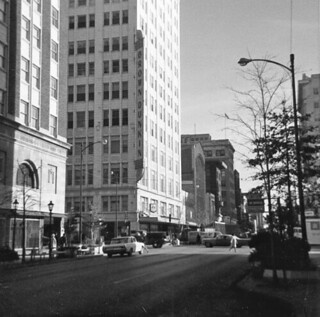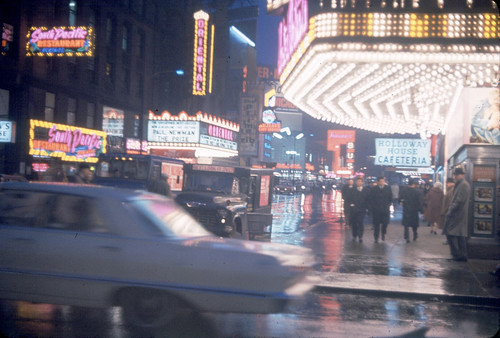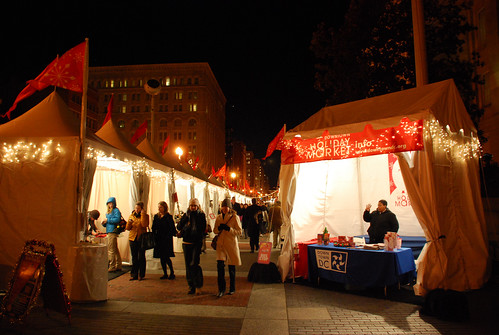Is the 'traditional' downtown a thing of the past? Is that OK?

Posted December 18, 2013 at 1:35PM
When I was a kid, people went downtown to do their Christmas (or whatever) shopping. That’s where the department stores were, the specialty clothing stores, the sporting goods and music stores, the toy stores, the shoe stores, the jewelers, the gift shops. Downtown was also where you’d find the most restaurants, theaters, and hangouts, where a group of us from high school might gather and eat burgers and fries after school before going the rest of the way home. Downtown was where most offices were, too, along with civic buildings and the library, the city auditorium.
This view of a traditional downtown remained true when I went off to undergrad school in Atlanta and law school in Washington, in the late 1960s and early 1970s. Downtown remained the best place to go shopping or do most anything else. It was where you went for excitement, a place with a critical mass of activity. Suburban malls were starting to sprout up with branches of the downtown stores, but the tragic flight of people and investment out of the city center hadn’t yet sapped all the life out of the central shopping district.
Indeed, readers of a certain age may recall the hit song, “Downtown,” by Englishwoman Petula Clark. After being released in four different languages, the song reached number one on the American charts in 1965:
When you're alone and life is making you lonely
You can always go downtown
When you've got worries, all the noise and the hurry
Seems to help, I know, downtownJust listen to the music of the traffic in the city
Linger on the sidewalk where the neon signs are pretty
How can you lose?
The lights are much brighter there
You can forget all your troubles, forget all your caresSo go downtown
Things will be great when you're downtown
No finer place for sure, downtown
Everything's waiting for youDon't hang around and let your problems surround you
There are movie shows downtown
Maybe you know some little places to go to
Where they never close downtown
Note the date of the song. I was in high school, as it happens.
We all know what happened next, unfortunately. Nearly every American city, along with most small towns, hollowed out in the decades to follow.  Except for cities with a long history of multifamily residential buildings downtown such as New York, Chicago and San Francisco, walkable central districts lost their shopping pizzazz along with their department stores and high-end retail (and a lot more).
Except for cities with a long history of multifamily residential buildings downtown such as New York, Chicago and San Francisco, walkable central districts lost their shopping pizzazz along with their department stores and high-end retail (and a lot more).
Aaron Renn, author of the long-running and always-provocative blog The Urbanophile, believes that my generation, the baby boomers, was the last to experience in large numbers the kind of downtown that Petula Clark sang about. Ten to fifteen years later, certainly twenty years later, it was over in most American cities.
The sense of loss suffered by boomers and previous generations as a result of what I might call The Great Disinvestment prevents many of us, Aaron suggests, from a more positive view toward urban progress today. Here’s a passage from his essay “The Rupture,” collected in his new e-book The Urban State of Mind: Meditations on the City. Although in this passage he is writing primarily about Rust Belt cities, I think his insights apply in a lot of places across the country:
“Gen-X and the Millennials have much more optimistic and positive views of urban areas than baby boomers and previous generations. I think this results from the rupture that those earlier generations experienced when our urban cores declined. If you read a newspaper interview of someone in that age bracket, you always hear the stories about the wonderful things they did in the city when they were younger. It was the land of good factory jobs, the downtown department store where their mothers took them in white gloves for tea, of the tidy neighborhoods, the long standing institutions and rituals – now all lost, virtually all of it. Unsurprisingly, this has turned a lot of people bitter. Many people saw everything they held dear in their communities destroyed, and they were powerless to stop it. T hese people are never going to be able to enter the Promised Land.
“For people about my age or younger, it’s a very different story. None of us knew any of those things. Our experience is totally different. We’ve basically never known a city that wasn’t lost. Gen-X, which Jim Russell views as the heartland of Rust Belt Chic, is a generation defined by alienation, so the alienated urban core suits our temperament perfectly. The Millennials of course have a very different attitude towards cities.” [Emphasis added.]
I don't know about the white gloves and tea, but I sure can identify with the rest of that first paragraph.
Although I know plenty of boomers who, like myself, have very positive and optimistic views of cities, I think Aaron is on to something. I know I have a very clear image of what an ideal downtown is, but that dream of a complete, exciting downtown serving as a hub of all things urban may well be lost in many American cities. Younger people never knew the concept of a healthy, unified downtown to begin with, so it doesn’t bother them that what is emerging today is more diffuse, less geographically centered, less complete, without large retail anchors where one might do much of one’s holiday shopping.
I’m not sure it bothers me, either, though I will confess to a certain nostalgia for the good old days. To take the DC example, I pretty much love what is happening in central Washington today – including, by the way, our outdoor holiday market. Downtown DC has become an exciting place again, to work, to eat, to gather, to shop.
But, generally speaking, the retail choices are fewer and much more limited, as well as more spread out among various shopping areas. I’m now in need of a sports store where I can buy a heart rate monitor, for example, and I’m not sure there is a good sporting goods store downtown. There’s one very good department store where I might find housewares and a variety of clothing, but only one. Not all of this retail shrinkage is due to disinvestment, of course – if the geography of buying and selling shifted dramatically once from city to suburb, it has changed yet again in the era of online shopping.
As for the other places I’ve lived, Atlanta’s downtown is but a very faded replica of what it once was. I visited a few years ago and found it terribly lifeless and depressing. I don’t spend much time in the Rust Belt, but I know it’s much worse there.
As for smaller cities, it varies. Some downtowns emptied out and have yet to rebound. Others are doing better: the lively, compact and walkable downtown of Asheville, where I grew up, has enjoyed a wonderful revival, as I wrote some time back. Most of the wonderful old art deco buildings are still there, but repurposed. The restaurant and bar scene is great, as are the galleries and high-end craft shops. There are new residential buildings downtown, which I find very encouraging, though I'm told they are very expensive to buy into. There’s still a first-rate independent bookstore.
But the clothing stores are long gone, with few exceptions. One certainly wouldn’t go downtown to buy housewares or sports equipment. I’d have to say that the retail in the old shopping district is now geared more to the city’s bustling tourist trade than to non-arty locals. I wouldn’t call it “traditional,” but it might represent some of the best of what’s possible today, instead of what once was.
And maybe that’s just fine. Times do change.
Would Petula Clark feel at home there, or in today’s downtown DC? Hard to say. But, just as many downtowns are re-emerging once again as exciting places, there may be some significance in the fact that she re-released "Downtown" in 2011, this time with my favorite Irish roots-rock band, the Saw Doctors. The song hit number two on the Irish pop charts. Enjoy the video:
Related posts:
- Is there a way to (downtown) San Jose? (by Lee Epstein) (May 6, 2013)
- The fall - and rise - of small downtown America (by Lee Epstein) (September 7, 2012)
- Rebuilding downtown from scratch: striking images and a video from Christchurch (June 22, 2012)
- Will downtown comebacks, entrepreneurs reverse commercial sprawl? (November 30, 2011)
- Will this historic downtown recover? (photoessay) (May 6, 2011)
- Tax revenue from downtown mixed-use outperforms big-box superstores and malls (July 14, 2010)
- R.I.P. Abe Pollin, the man who improved downtown (November 25, 2009)
- Small-city smart growth: you can't go home again - or can you? (part 1) (January 14, 2008)
- Small-city smart growth: you can't go home again - or can you? (part 2) (January 15, 2008)
Move your cursor over the images for credit information.

